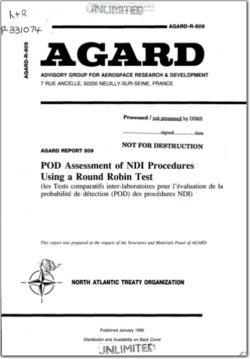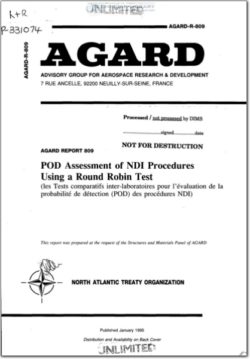AGARD-R-809

- Version
- 190 Downloads
- 7.52 MB File Size
- 1 File Count
- April 25, 2016 Create Date
- April 25, 2016 Last Updated
POD Assessment of NDI Procedures Using a Round Robin Test

Components of aircraft engines are retired when they have reached a given number of operational cycles known as the "Safe Life
Limit", which is based on an acceptably low probability of the formation of a detectable crack. However, the majority of parts at
retirement still have useful life which will not be fully utilized. The costs and logistics associated with spare part replacement under
the "safe life" maintenance philosophy are high. Therefore, the development of an attractive life management procedure that would
allow continued safe use of components beyond the safe life limit is of interest to the air forces of several NATO countries. The
foremost requirement known is that any new method must not jeopardize operational safety.
The US. Air Force has recently implemented a new maintenance philosophy known as "Retirement For Cause" (RFC) to extend the
use of gas turbine engine parts beyond their original design safe life cycle. This is a result of the Engine Structural Integrity Program
(ENSIP) as defined in MIL-STD-1783. The RFC approach is based on a "Damage Tolerance" (DT) design philosophy which assumes
that all parts contain flaws. By using routine nondestructive inspections and fracture mechanics predictions, the DT approach ensures
that the flaws will not grow to critical size during service.
Inspection, according to damage tolerance criteria, requires that the NDI procedures be quantified in terms of their sensitivity and
reliability as defined by probability of detection (POD) and confidence limit measurements. The POD for NDI procedures can be
assessed experimentally by inspecting statistically valid numbers of flawed and flaw-free parts using procedures that duplicate
maintenance inspections. A comprehensive document describing testing and evaluation procedures for assessing the capability of an
NDI system using POD and confidence limits has been published by AGARD [2]. The present work uses Reference 2 as a guideline
to assess the NDI procedures employed by six laboratories from four NATO countries that participated in this demonstration project.
The aim of the project is to determine the degree of reliability and the level of sensitivity of NDI procedures presently employed by
the participating laboratories. The results of this study will be useful in determining whether or not the employed NDI procedures are
adequate for the implementation of a DT-based maintenance approach, and therefore whether improved methods are needed.
| File | Action |
|---|---|
| AGARD-R-809 POD Assessment of NDI Procedures Using a Round Robin Test.pdf | Download |

Comment On This Post